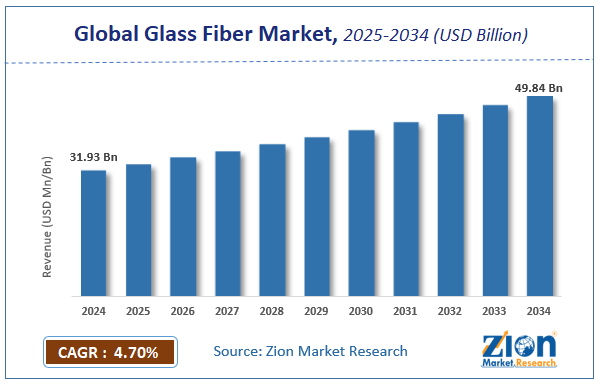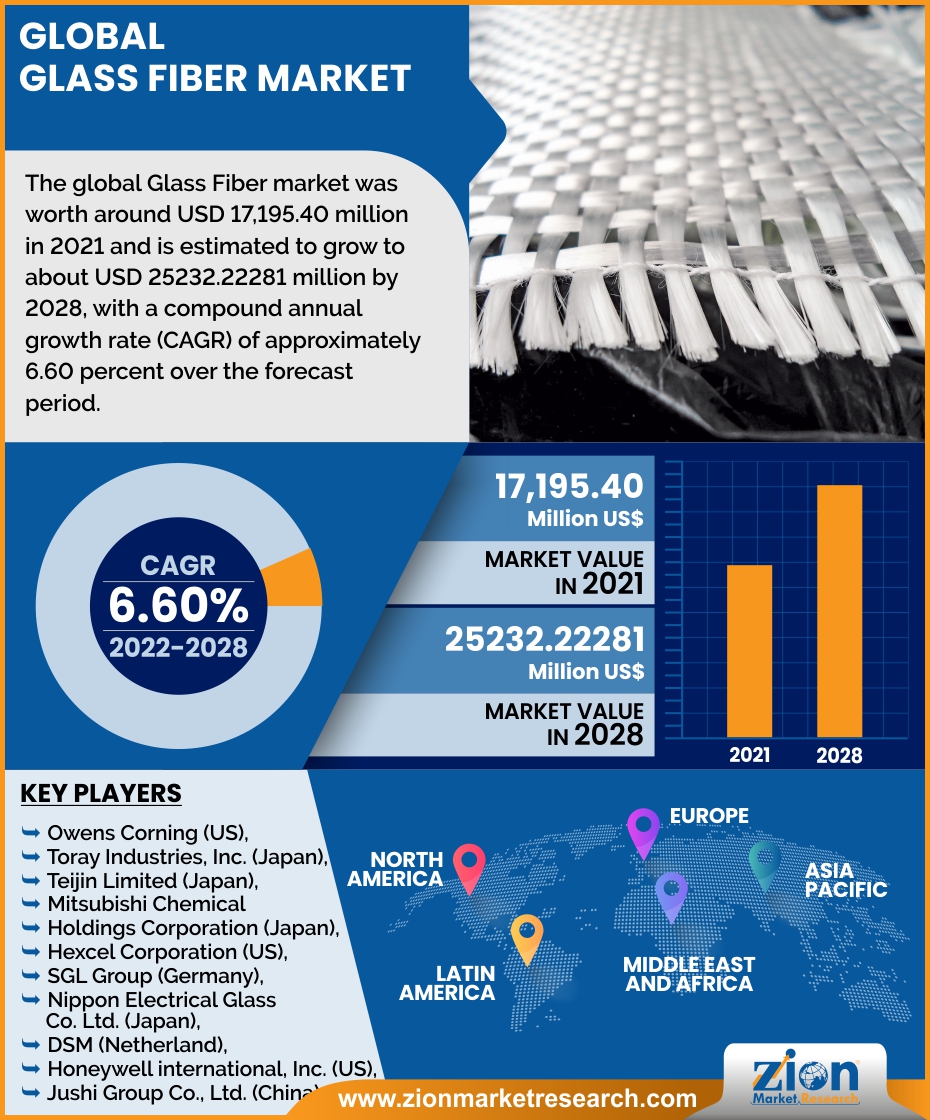Glass Fiber Market Size, Share, Analysis, Trends, Growth, 2034

Glass Fiber Market By Type (Glass, Carbon, Aramid, Ultra-High Molecular Weight Polyethylene (UHMWPE) Fibers, Polyphenylene Sulfide (PPS) Fibers and Other Fibers), By Application (Composite and Non-Composite), By End use (Aerospace & defense, Wind Energy, Transportation, Construction & Infrastructure, Marine, Pipe & Tank, Electrical & Electronics, Protective Clothing and Others) and By Region - Global Industry Overview, Market Intelligence, Comprehensive Analysis, Historical Data and Forecasts 2025 - 2034
| Market Size in 2024 | Market Forecast in 2034 | CAGR (in %) | Base Year |
|---|---|---|---|
| USD 31.93 Billion | USD 49.84 Billion | 4.7% | 2024 |
Industry Prospective:
The global glass fiber market size was worth around USD 31.93 Billion in 2024 and is predicted to grow to around USD 49.84 Billion by 2034 with a compound annual growth rate (CAGR) of roughly 4.7% between 2025 and 2034. The report analyzes the global glass fiber market's drivers, restraints/challenges, and the effect they have on the demands during the projection period. In addition, the report explores emerging opportunities in the glass fiber industry. The report analyzes the Glass Fiber market’s drivers, restraints/challenges, and the effect they have on the demands during the projection period. In addition, the report explores emerging opportunities in the Glass Fiber market.
Glass Fiber Market: Overview
Glass fibres are one of the most versatile industrial materials, consisting of numerous extremely fine glass fibres. Glass fibres are used as polymer reinforcement in a variety of industries, including aerospace, automotive, marine, sporting and leisure goods, and construction and civil engineering. During the next five years, glass fibres are expected to dominate the overall market in terms of volume and value. Because of their low cost and superior physical and mechanical properties such as strength, durability, flexibility, stability, and lightweight, glass fibres are in high demand. E-glass fibres are commonly used in the wind energy, pipes and tanks, electrical and electronics, and construction and infrastructure industries. High strength glass, such as R, S, S-2, and advances, is used in the aerospace and defence, automotive and transportation, and wind energy industries, among others.
The automotive and transportation industries have witnessed a significant increase in demand for fibreglass panels, fibreglass resin, and fibreglass epoxy. The demand for these composite materials is driven by their ability to make vehicle structures lower in weight while maintaining strength. The growing popularity of electric vehicles has raised the need to make vehicles lighter, which is likely to drive demand for fibreglass materials.
Key Insights
- As per the analysis shared by our research analyst, the global glass fiber market is estimated to grow annually at a CAGR of around 4.7% over the forecast period (2025-2034).
- Regarding revenue, the global glass fiber market size was valued at around USD 31.93 Billion in 2024 and is projected to reach USD 49.84 Billion by 2034.
- The glass fiber market is projected to grow at a significant rate due to increasing use in construction, automotive, and wind energy applications.
- Based on Type, the Glass segment is expected to lead the global market.
- On the basis of Application, the Composite segment is growing at a high rate and will continue to dominate the global market.
- Based on the End use, the Aerospace & defense segment is projected to swipe the largest market share.
- Based on region, Asia-Pacific is predicted to dominate the global market during the forecast period.
Glass Fiber Market: Growth Drivers
Driver:
- In the renewable energy sector, there is a growing demand for advanced materials.
- Automobile, aerospace, and marine industries are all in high demand.
- Optical Fiber Cables and Electronics are in High Demand.
Restraint:
- High production costs
- Recycling issues
- A lack of R&D funding for specialty synthetic fibers
Opportunity:
- Glass Fibre Pipes are in high demand in emerging economies.
- In the Middle East and North Africa, there is a growing need for glass fibres in the construction and infrastructure industries.
Challenge:
- Developing Low-Cost fibers.
Glass Fiber Market: Report Scope
| Report Attributes | Report Details |
|---|---|
| Report Name | Glass Fiber Market |
| Market Size in 2024 | USD 31.93 Billion |
| Market Forecast in 2034 | USD 49.84 Billion |
| Growth Rate | CAGR of 4.7% |
| Number of Pages | 180 |
| Key Companies Covered | Owens Corning (US), Toray Industries Inc (Japan), Teijin Limited (Japan), Mitsubishi Chemical Holdings Corporation (Japan), Hexcel Corporation (US), SGL Group (Germany), Nippon Electrical Glass Co. Ltd. (Japan), DSM (Netherland), Honeywell international I, and others. |
| Segments Covered | By Type, By Application, By End use, and By Region |
| Regions Covered | North America, Europe, Asia Pacific (APAC), Latin America, The Middle East and Africa (MEA) |
| Base Year | 2024 |
| Historical Year | 2020 to 2023 |
| Forecast Year | 2025 - 2034 |
| Customization Scope | Avail customized purchase options to meet your exact research needs. Request For Customization |
Global Glass Fiber Market: Segmentation
The global Glass Fiber market is segregated based on Type, Application and End use.
By end use, the market is classified into Aerospace & defense, Wind Energy, Transportation, Construction & Infrastructure, Marine, Pipe & Tank, Electrical & Electronics, Protective Clothing and Others. This category had a significant share in 2021 and is expected to maintain its dominance throughout the forecast period. Wind energy is expected to have the biggest share in terms of volume during the projection period. In the production of wind turbine blades, nacelles, and hubs, glass and specialty synthetic fibers are in high demand. Many businesses are investing in the development of composite materials for the wind energy industry.
By application, the market is divided into composites and non-composites. Composites accounted for the highest share of the market and are expected to increase rapidly over the forecast period. Composites are multiphase materials that have been synthesized artificially in order to achieve a favorable mix of materials. Composites are typically materials made up of high-strength fibers with a high modulus inserted in or bonded to a matrix with different interfaces.
Recent Developments
- In July 2019, Teijin and AEV Robotics (Australia) have agreed to collaborate on lightweight automobile solutions for future transportation. Teijin's high-performance carbon and aramid fibers would be used in these automobile solutions.
- In June 2020, Valmiera's production facility in Dublin, GA was recently purchased by Vetrotex. The company's footprint in America will be strengthened as a result of this investment.
Regional Landscape
North American demand for fiberglass accounts for the largest share. Increased investment in the construction and building industries is expected to drive North American fiberglass consumption.
In the global glass fibre market, Asia Pacific accounted for the greatest proportion. In the future years, APAC is predicted to be the fastest-growing market for glass fibers. The need for glass fibre has increased significantly in the region as a result of the expansion of the transportation, construction, electrical and electronics, aerospace, and other industries. Glass fibers are used extensively in the construction industry. The need for advanced glass fibers is being driven by rapid infrastructure development in emerging economies such as India and China.
Competitive Landscape
The report provides a company market share analysis to give a broader overview of the key market players. In addition, the report also covers key strategic developments of the market, including acquisitions & mergers, new product launches, agreements, partnerships, collaborations & joint ventures, research & development, and regional expansion of major participants involved in the glass fiber market on a global and regional basis.
Some of the main competitors dominating the global Glass Fiber market include –
- Owens Corning (US)
- Toray Industries, Inc. (Japan)
- Teijin Limited (Japan)
- Mitsubishi Chemical Holdings Corporation (Japan)
- Hexcel Corporation (US)
- SGL Group (Germany)
- Nippon Electrical Glass Co. Ltd. (Japan)
- DSM (Netherland)
- Honeywell international, Inc. (US)
- Jushi Group Co., Ltd. (China).
The market is segmented as follows:
By Fiber Type:
- Glass
- Carbon
- Aramid
- Ultra-High Molecular Weight Polyethylene (UHMWPE) Fibers
- Polyphenylene Sulfide (PPS) Fibers
- Other Fibers
By Application:
- Composite
- Non-Composite
By End-use industry:
- Aerospace & defense
- Wind Energy
- Transportation
- Construction & Infrastructure
- Marine
- Pipe & Tank
- Electrical & Electronics
- Protective Clothing
- Others
By Region
- North America
- The U.S.
- Canada
- Mexico
- Europe
- France
- The UK
- Spain
- Germany
- Italy
- Rest of Europe
- Asia Pacific
- China
- Japan
- India
- Australia
- South Korea
- Rest of Asia Pacific
- The Middle East & Africa
- Saudi Arabia
- UAE
- Egypt
- Kuwait
- South Africa
- Rest of the Middle East & Africa
- Latin America
- Brazil
- Argentina
- Rest of Latin America
Table Of Content
Methodology
FrequentlyAsked Questions
The automotive and transportation industries have witnessed a significant increase in demand for fibreglass panels, fibreglass resin, and fibreglass epoxy. The demand for these composite materials is driven by their ability to make vehicle structures lower in weight while maintaining strength. The growing popularity of electric vehicles has raised the need to make vehicles lighter, which is likely to drive demand for fibreglass materials.
According to a study, the global glass fiber market size was worth around USD 31.93 Billion in 2024 and is expected to reach USD 49.84 Billion by 2034.
The global glass fiber market is expected to grow at a CAGR of 4.7% during the forecast period.
Asia-Pacific is expected to dominate the glass fiber market over the forecast period.
Leading players in the global glass fiber market include Owens Corning (US), Toray Industries Inc (Japan), Teijin Limited (Japan), Mitsubishi Chemical Holdings Corporation (Japan), Hexcel Corporation (US), SGL Group (Germany), Nippon Electrical Glass Co. Ltd. (Japan), DSM (Netherland), Honeywell international I, among others.
The report explores crucial aspects of the glass fiber market, including a detailed discussion of existing growth factors and restraints, while also examining future growth opportunities and challenges that impact the market.
RelatedNews
HappyClients
Zion Market Research
Tel: +1 (302) 444-0166
USA/Canada Toll Free No.+1 (855) 465-4651
3rd Floor,
Mrunal Paradise, Opp Maharaja Hotel,
Pimple Gurav, Pune 411061,
Maharashtra, India
Phone No +91 7768 006 007, +91 7768 006 008
US OFFICE NO +1 (302) 444-0166
US/CAN TOLL FREE +1 (855) 465-4651
Email: sales@zionmarketresearch.com
We have secured system to process your transaction.
Our support available to help you 24 hours a day, five days a week.
Monday - Friday: 9AM - 6PM
Saturday - Sunday: Closed







